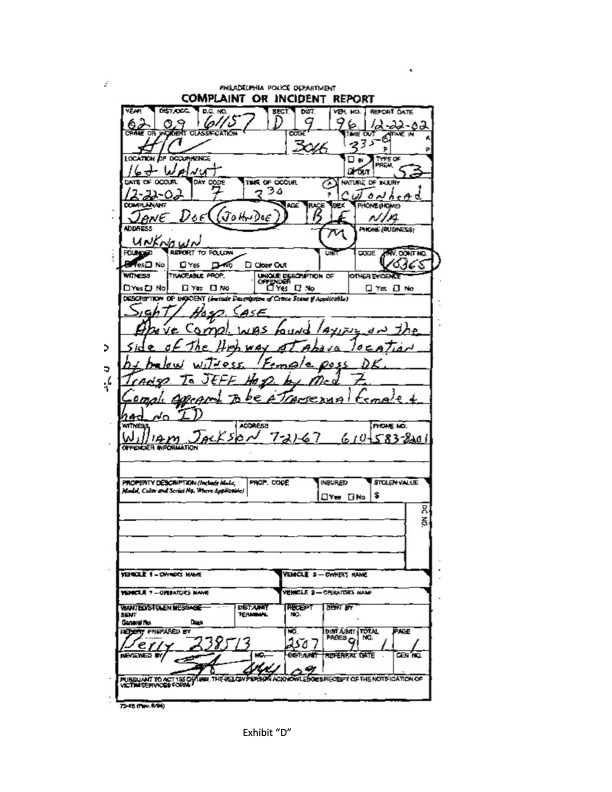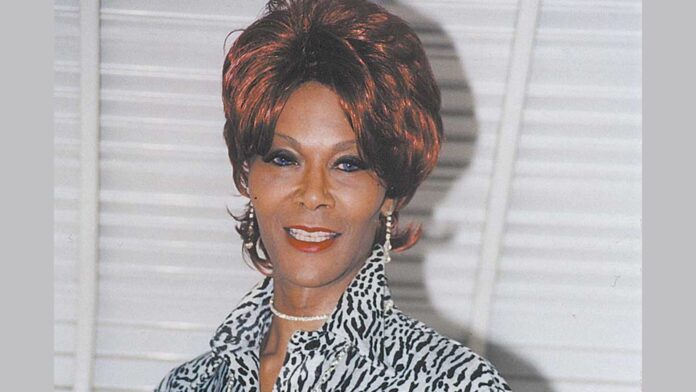One of the more troubling aspects of the Nizah Morris case is a police report written by one of the three officers who responded to her on the morning of her fatal head injury.
PGN recently supplied a copy of the unredacted report to police investigators taking a new look at the Morris case. An Internal Affairs probe in 2004-5 didn’t have access to an unredacted copy of the report because it was confined to a homicide file that was missing at the time.
Morris, 47, was a Philadelphia trans woman of color who was found with a fatal head injury shortly after receiving a “courtesy ride” by police. Her homicide remains unsolved.
Thomas Berry, Elizabeth Didonato and Kenneth Novak are three officers who responded to Morris during the pre-dawn hours of Dec. 22, 2002, when the incident occurred.
Berry’s report accompanies this story. The parts of Berry’s report that were redacted by authorities are circled. In 2011, police released an unredacted version of Berry’s report to PGN, after it was located in the city’s Archives Unit.
Police report doesn’t mention courtesy ride
A major concern raised by Berry’s report is that it depicts the Morris incident as beginning at 16th and Walnut where Morris was found with a head injury — rather than four blocks east at Juniper and Chancellor, where a courtesy ride for Morris began shortly before her head injury.
Morris was inebriated at the time and Didonato told investigators she wanted to take Morris home. So Didonato transported her from Juniper and Chancellor to the 1400 block of Walnut Street. But Morris lived in West Philadelphia, not on the 1400 block of Walnut.
Berry told investigators he first spotted Morris inside Didonato’s vehicle on the 1400 block of Walnut. Berry used that initial sighting of Morris to help him estimate the time she supposedly fell and cut her head at 16th and Walnut. In the box of his report for Time of Occurrence, Berry wrote “3:30” a.m.
Since Berry used his initial sighting of Morris inside Didonato’s vehicle to help him estimate a Time of Occurrence, it’s all the more perplexing why he didn’t write a comprehensive report beginning at Juniper/Chancellor — unless he wanted to conceal the courtesy ride.
In fairness to Berry, he may have assumed Novak would write a comprehensive report — because Novak was the first officer to go to Jefferson Hospital after medics took Morris there. At Jefferson, Novak requested that Berry meet him there. However, Novak never wrote a comprehensive report about the Morris incident.
Report represents Morris as a drunk person who fell
Another troubling aspect of Berry’s report is that it represents Morris as a drunk person taken to a hospital by medics rather than as an assault victim. The patrol logs of Novak and Didonato similarly represent Morris as merely a drunk person who fell – not an assault victim.
Morris’ attending physician at Jefferson suspected that Morris was an assault victim and documented his concerns in hospital records. But it’s unclear if Berry spoke to the attending physician when he visited Jefferson later that morning.
At the hospital, Morris was comatose and near death. She had a fractured skull and a subdural hematoma. She lingered for 64 hours before dying at 8:30 p.m. on Dec. 24, 2002.
Berry’s report also describes Morris as a “compl[ainant],” which gives the impression that Morris was conscious. Actually, Morris was unconscious at 16th and Walnut and bleeding profusely from the head.
Report doesn’t mention Morris was nude from waist up
Oscar Padilla, a passing motorist at 16th and Walnut, said Morris was naked from the waist up.
“She [Morris] was naked to the waist and she was wearing black pants,” Padilla told a homicide detective. “She had one leg bent up at the knee with her foot flat on the ground and her other leg was straight out. She had one arm above her head and the other was down near her side. She was breathing pretty heavily but she was unconscious…I flagged [Berry] down as [he] almost drove past where we were. I told the officer that I had found her lying in the street just the way she was. The paramedics arrived and there was a lot of blood on the ground where her head was lying.”
Berry’s report doesn’t mention that Morris was nude from the waist up nor that she was unconscious and had a pool of blood under her head. Those facts would indicate Morris was a crime victim, not someone who merely slipped and fell.
Berry told investigators he thought Morris tripped over a raised surface — he called it a “buckle” — on Walnut Street. However, if such a buckle existed, it’s never been photographed or preserved in any manner by investigators.
Morris was lying on her back at 16th and Walnut and her head injury was on her right forehead. Thus, it remains unclear why Berry thought she cut her head when falling onto Walnut Street — rather than being struck by someone on her forehead.
Report states Morris had no identification on her
Berry’s report states Morris had no identification on her. However, personnel at Jefferson Hospital located identifying information on her and left messages on her voicemail machine. Jefferson personnel were diligently trying to reach relatives of Morris before she died.
PGN has a cassette tape of those voicemail messages and supplied the tape to investigators taking a new look at the Morris case.
Report speculates about Morris’ LGBTQ+ status
For no apparent reason, Berry’s report speculates about Morris’ transgender status, stating that she appeared to be a “transsexual female.” PGN has interviewed numerous police officers over the years who said it would be extremely unusual for an officer to speculate about someone’s LGBTQ+ status in a police report for a simple “hospital case.”
Typically, a report wouldn’t even be written about a “hospital case” unless police transported the person to a hospital, according to officers interviewed by PGN.
Moreover, Berry’s report assigns two genders to Morris along with a male pseudonym and a female pseudonym. But Morris didn’t identify as two-spirit, nor was she intersex.
Report wrongly identifies person who found Morris
Berry’s report falsely states that Morris was found by William Jackson. In actuality, Morris was found by Oscar Padilla, a fact that’s verified by 911 recordings. Padilla said he flagged Berry down as Berry drove by the scene.
Jackson arrived at 16th and Walnut after Padilla. Jackson was interviewed by homicide investigators and said he thought Morris was grievously wounded, her eyes wide open and staring into the sky.
Jackson never told Berry he was the first person to find Morris — nor did Jackson convey that Morris was a slip-and-fall victim. But Jackson did tell Berry he recognized Morris as an entertainer who worked at Bob and Barbara’s Bar. This information regarding Morris’ employment wasn’t included in Berry’s report.
Report’s existence denied by police
For several weeks after Morris was killed, Philadelphia police denied the existence of Berry’s report. Police officials even went so far as to send an official statement to PGN via the U.S. Postal Service, denying the report’s existence. That false notification has been provided to investigators taking a new look at the Morris case.
In April 2003, after a sister of Morris stated publicly that she saw a police report among the papers of a detective who visited Morris’ relatives, police released Berry’s report.
However, the report released by police in 2003 was redacted — concealing Berry’s male references to Morris. Also redacted was the investigation control number assigned to the report. The unredacted version of Berry’s report wasn’t released by police until 2011. Next week, PGN will examine the possible reasons why Berry referred to Morris’ LGBTQ+ status in his report.


